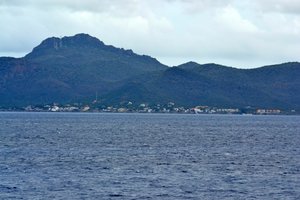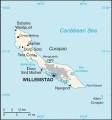Advertisement

 Christoffelberg
Christoffelberg
Christoffelberg. Highest point on Curaçao at 1,220 feet (372 m). DSC_0655p1Carnival Sunshine arrived off Curaçao after 11:00 a.m. on the third day of the cruise. Curaçao, along with Aruba and Bonaire (the ABC islands), has been a Dutch possession since the 17th century. Despite their proximity, we found the ABC islands have little interaction with one another. There is no ferry service, for example, between them.
The ship sailed at a leisurely pace along the 30 mile long island, docking at Willemstad at the scheduled time of 1:00 p.m. Rain threatened, but held off. I enjoyed seeing the changing landscape. Christoffelberg in the northern part of the island is the highest point on Curaçao at 1,220 feet (372 m). The coastline is dotted with small communities and resort developments leading down to Willemstad. There are also signs of industry. Like Aruba, Curaçao has oil refineries. The tourism industry in the ABC islands has been developed since the late 1950s.
The cruise terminal at Willemstad is in the Otrabanda District, across the riverlike Sint Annabaai (St. Ann's Bay) from the Punda District. It was an easy walk from the terminal through the Rif Fort to the Queen Emma Bridge. The Rif Fort (Reef Fort), dating from 1828, guarded the Otrobanda

 Penha Building
Penha Building
Penha Building. Originally a merchant's house (1708). It is still a commercial building on the ground floor. Historic Area of Willemstad, Inner City and Harbour, Curaçao UNESCO World Heritage site. Inscribed in 1997.
DSC_0778side of the port. The fort has been adapted as the Renaissance Mall shopping area. However, the walls, sally ports and lookouts have been preserved.
The view across Sint Annabaai to Punda is like seeing Amsterdam in pastels. Dutch architecture with its distinctive curved gables is in evidence. But the buildings are painted in bright Caribbean colors. There are two ways across: Ferry and the Queen Emma pedestrian-only pontoon bridge. (There is a highway bridge further up the harbor. We took the Queen Emma pedestrian bridge across the bay. It's an experience by itself. The bridge can swung to allow ships to pass through the channel. (But not without plenty of warning!)
The "Historic Area of Willemstad, Inner City and Harbour, Curaçao" is a UNESCO World Heritage site. The Netherlands has been present in Curaçao since the construction of Fort Amsterdam in 1634. Punda, the oldest part of the city, grew adjacent to the fort and retains its Dutch colonial appearance. Susan and I decided to first look at the Fort Amsterdam area. Construction of Fort Amsterdam began just after Dutch occupation of the island. A modern hotel dominates the main part of the old fort. However, historic

 De drie gebroeders
De drie gebroeders
De drie gebroeders = The Three Brothers. Trio of peaks at Piscadera, Curaçao.
Zwarte Berg, Jacque Everts Berg, Veeris Berg.
DSC_0677p1parts of the fort do remain and are in use as government offices. The Governor's Palace is the seat of Curaçao's government. One can walk through the entry arch into the courtyard. (The courtyard is used as a car park.) At the far end of the courtyard is the 17th century Fort Church, an active Protestant church. It has a museum and is open for tours in the morning hours. Unfortunately, we were here in the afternoon and it was closed.
Continuing up Handelskade (the street running along the waterfront from the fort) we stopped in several shops in the old buildings. Around the corner was the floating market. "Floating" because produce is brought in by sea from nearby South America. I needed to pick up some items at a pharmacy, called a "
botica" in Curaçao. The botica staff showed they were fluent in English, Dutch and Papiamento, the local language. (Papiamento is a blend of Portuguese with African languages, Spanish and Dutch.)
Nearby we found Synagogue Mikvé Israel-Emanuel, the oldest continuously active synagogue in the Western Hemisphere. The synagogue has a museum and we saw both the museum and the synagogue itself. Constructed in 1732, the synagogue

 Ararat Hill
Ararat Hill
Berg Ararat = Ararat Hill overlooking Willemstad, Curaçao. . The smokestacks show the industry present on the island. DSC_0703p1was modeled after the Portuguese Synagogue of Amsterdam. (It was founded by 12 Jewish families who came from Amsterdam.) It served a Spanish and Portuguese Jewish community from the Netherlands and Brazil. (The congregation had been founded in 1651.) The museum is to one side of the synagogue's walled courtyard. Two floors of exhibits show torahs and religious and cultural artifacts related to the synagogue over nearly four centuries and personal exhibits about the families and and the life of the congregation. The family exhibits relate personal stories of life on Curaçao over the years. Family photos and wedding photos document the everyday life of the congregation. Some of the family names can be seen on businesses in Willemstad today. There are some fascinating stories here. There is the story of George Maduro, son of a still-prominent family, who was studying law in the Netherlands when World War II broke out. He was killed in the war. (Madurodam park in the Netherlands is named for him.) I was struck by the many stories about the
yayas. A yaya was an Afro-Caribbean nanny employed by prominent families. In so many of the personal stories about the congregation and life on the

 Welcome to Curaçao!
Welcome to Curaçao!
I ♥︎ Curaçao sign at the Rif Fort. DSC_0713island people wrote of their yaya. It was evident that people remained close and looked after their yaya in her old age. (A yaya dress and hat are on display.) After the museum, we went into the synagogue. The floor is covered with sand to represent the desert of Egypt. Beautifully carved mahogany woodwork fills the interior. Elegant chandeliers hang from the ceiling.
Continuing back around to the waterfront area, there were many more colonial era buildings and a park with a large "Dushi Curacao" (I Love Curacao) sign. It was as popular as the "I Love Amsterdam" sign for taking selfies and group photos!
Susan and I made our way back to Otrabanda and the ship after a bit of shopping and taking in more of the Dutch/Caribbean atmosphere. The Queen Emma bridge was swung open this time, to allow the passage of Club Med 2 out of the harbor. Club Med 2 is a French cruise ship, a hybrid tall sailing ship and motor ship. It's quite a sight to see! As the bridge would not reopen for a time, we elected to take the ferry back across the Sint Annabaai. The ferry is free. You

 Carnival Sunshine
Carnival Sunshine
Carnival Sunshine at Willemstad, Curaçao. DSC_0708just board one and when it is full it sails across to Otrabanda.
One item we bought was a box of
Bolo Pretu. Bolo Pretu is the ABC Islands version of the Trinidadian Black Cake. Both are Caribbean adaptations of British and European plum puddings and fruitcakes. However, they are infused with much sugar and rum, and in the case of Bolo Pretu, blue Curaçao liqueur.
Sailing time was not until 10:00 p.m. The late departure allowed a beautiful view of Willemstad at night from the ship. The waterfront was illuminated and the Queen Emma bridge displayed changing bands of colored lights.
Advertisement
Tot: 0.084s; Tpl: 0.017s; cc: 9; qc: 26; dbt: 0.0394s; 1; m:domysql w:travelblog (10.17.0.13); sld: 1;
; mem: 1.1mb



 Christoffelberg
Christoffelberg
 Penha Building
Penha Building
 De drie gebroeders
De drie gebroeders
 Ararat Hill
Ararat Hill
 Welcome to Curaçao!
Welcome to Curaçao!
 Carnival Sunshine
Carnival Sunshine




























